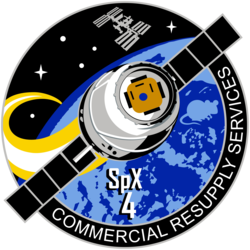 CRS-4 Dragon approaching ISS on 23 September 2014 | |
| Names | SpX-4 |
|---|---|
| Mission type | ISS resupply |
| Operator | SpaceX |
| COSPAR ID | 2014-056A |
| SATCAT no. | 40210 |
| Mission duration | 34 days, 13 hours, 46 minutes |
| Spacecraft properties | |
| Spacecraft | Dragon 1 C106 |
| Spacecraft type | Dragon 1 |
| Manufacturer | SpaceX |
| Launch mass | 6,000 kg (13,000 lb) |
| Dry mass | 4,200 kg (9,300 lb) |
| Start of mission | |
| Launch date | 21 September 2014, 05:52:03 UTC [1] |
| Rocket | Falcon 9 v1.1 (B1010) |
| Launch site | Cape Canaveral, SLC-40 [2] [3] |
| End of mission | |
| Disposal | Recovered |
| Landing date | 25 October 2014, 19:39 UTC [4] |
| Landing site | Atlantic Ocean |
| Orbital parameters | |
| Reference system | Geocentric orbit |
| Regime | Low Earth orbit |
| Inclination | 51.6° |
| Berthing at International Space Station | |
| Berthing port | Harmony nadir |
| RMS capture | 23 September 2014, 10:52 UTC [5] |
| Berthing date | 23 September 2014, 13:21 UTC [5] |
| Unberthing date | 25 October 2014, 12:02 UTC |
| RMS release | 25 October 2014, 13:56 UTC [6] |
| Time berthed | 31 days, 22 hours, 41 minutes |
| Cargo | |
| Mass | 2,216 kg (4,885 lb) [1] |
| Pressurised | 1,627 kg (3,587 lb) |
| Unpressurised | 589 kg (1,299 lb) |
 NASA SpX-4 mission patch | |
SpaceX CRS-4, also known as SpX-4, [7] was a Commercial Resupply Service mission to the International Space Station (ISS), contracted to NASA, which was launched on 21 September 2014 and arrived at the space station on 23 September 2014. It was the sixth flight for SpaceX's uncrewed Dragon cargo spacecraft, and the fourth SpaceX operational mission contracted to NASA under a Commercial Resupply Services contract. The mission brought equipment and supplies to the space station, including the first 3D printer to be tested in space, a device to measure wind speed on Earth, and small satellites to be launched from the station. It also brought 20 mice for long-term research aboard the ISS.







